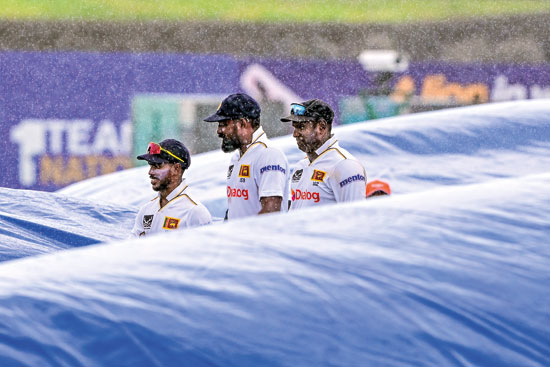Sri Lanka spinners: Cobble out or be left out
When Prabath Jayasuriya walked off the field at Galle with figures of 0-154 from 48 overs at the end of Bangladesh’s first innings, it wasn’t just a bad day at the office—it was a damning symbol of Sri Lankan cricket’s deeper malaise.
For a bowler who had previously claimed 80 wickets in just 10 matches at this very ground, such returns were nothing short of catastrophic. Galle, the fortress where visiting batsmen have historically been reduced to nervous wrecks by spinning wizards, had suddenly become ordinary. The magic has gone.

Will the upcoming phase be a gloomy one for the local spinners, including the now frontliner Prabath Jayasuriya (centre) - AFP
Jayasuriya’s collapse reveals a troubling truth about modern Sri Lankan spin bowling. When the pitch refused to offer its usual assistance—no sharp turn, no uneven bounce—the left-arm spinner looked utterly lost. His away record tells the real story: just 26 wickets in eight overseas matches at a woeful average of 46.57.
This situation isn’t just about one bowler’s difficulties. It reflects an entire generation of Sri Lankan spinners trapped in what we might call ‘the Galle trap’. They rely too much on home conditions, leaving them unprepared when the ball doesn’t spin or grip.
The difference between today’s spinners and the legends of Sri Lankan cricket is striking and painful. Muttiah Muralitharan didn’t just take 800 Test wickets; he changed what it took and meant to be that match-winning spinner in any condition, anywhere. His 125 wickets in the demanding SENA countries (South Africa, England, New Zealand, Australia) at an average of 26.69 came not from depending on favourable pitches but from exceptional cricket intelligence.
On Galle’s turning tracks, Murali would flight the ball generously, using his complete range of skills to confuse batsmen. However, his true talent showed when conditions were tough. He understood that different situations needed different tactics, yet he remained effective in any setting.
Then there was Rangana Herath—a clever spinner who proved that thought could overcome physical advantages. Lacking Murali’s unique skills, Herath compensated with relentless discipline and smart strategies. His 433 Test wickets at 28.07 came from consistently hitting the same spot, applying pressure like a skilled chess player, and forcing batsmen to crack under his reliability.
Today’s top spinners have unlocked the secrets that escape Sri Lanka’s current talents. Australia’s Nathan Lyon has taken 399 wickets in SENA countries—where spin is generally not favoured. He relies not on sharp turns but on subtle changes and long spells that wear down even the toughest batsmen.
Ravindra Jadeja transformed from a limited-overs player into a Test match expert through sheer discipline. Even on unresponsive pitches, he keeps threatening lines, creating pressure through careful precision instead of waiting for miraculous deliveries. Keshav Maharaj has made spin bowling relevant in South Africa—a place that usually does not favour slow bowlers—by focusing on smart flight variations and steady accuracy.
The current Sri Lankan spinners—Jayasuriya, Ramesh Mendis, Lasith Embuldeniya, Praveen Jayawickrema—represent a sad break from this rich legacy. They have mastered one approach: bowl with generous flight on turning tracks and wait for the pitch to help. When that assistance disappears, they struggle.
Against Bangladesh, when the Galle pitch provided little turn, Jayasuriya seemed to be waiting for conditions to improve instead of creating chances with his skill. It was a display of helplessness—the opposite of what Murali and Herath stood for.
Sri Lanka’s spin bowling problem isn’t hopeless, but it needs serious changes. One step could be to stop creating spinning highways that lead to false expectations. Varied pitches that mimic global conditions will force bowlers to develop complete skills. Another approach could be to adopt the Herath model—discipline, consistency, and building pressure through precision instead of luck.
Sri Lanka is at a turning point. The country that produced Murali’s magic and Herath’s skill has become a source of one-dimensional players who struggle under pressure. The answer isn’t to abandon Sri Lanka’s spin bowling history; it’s to reclaim the greatness that made it legendary.
Murali and Herath succeeded not because they had favourable pitches but because they could think, adjust, and perform under any circumstances. The numbers speak for themselves: 800 and 433 Test wickets, respectively. These records of greatness were built on skill, intelligence, and adaptability—qualities that surpass conditions and define true excellence.
Sri Lanka’s current spinners must learn these lessons or they will keep struggling. Sri Lanka can rise again, but only if it remembers what made it great in the beginning: spinners who could thrive anywhere, anytime, through their skill and cricket intelligence.


